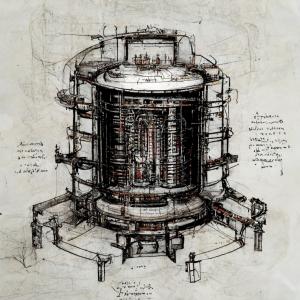Da Vinci's (clearly) impossible drawing
The Hungarian physicist has also developed an interest in AI-generated drawings. "I began experimenting with this technology, using different software platforms to create illustrations for the public science talks and presentations I occasionally give," he explains. From there, it was not a large step to try and generate a Leonardo-style tokamak sketch, which proved quite difficult. "However, after about a dozen image 'generations' the result was very close to what I had imagined." This is putting in mildly: despite its inherent impossibility, a tokamak drawing by Leonardo would have been very close to what Daniel produced using AI software.
A good April Fool's news item needs to be both plausible when you come across it the first time and totally outlandish on second thought. As it had been discovered a few weeks ago that Leonardo had devised experiments to investigate the nature of gravity, could he have also explored ways of harnessing fusion energy? Reason said no, of course. But something, for a few seconds, said: "Why not, after all?"
And that's what the fun was all about.


